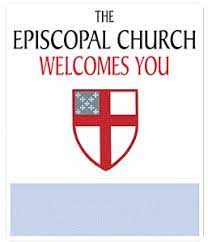For over 55 years the “Episcopal Church Welcomes You” sign identified Episcopal churches to people around the world. These signs became one of the most recognizable symbols of our denomination. At their inception, the signs were considered an important part of the Church’s outreach to the world. Regrettably, many of these signs have not weathered the years well. Many have rusted and faded from years of exposure. Some are bent. Others lean as their stanchions shifted with the soil beneath. In seeing these signs, I often ask, “What are these signs saying about our Church?”
St. Luke’s has not used this ubiquitous symbol at its campus for quite some time. Did you know that we DO use them on the major roads leading into the City of Lebanon? When was the last time you noticed one of these? How often do you think others do?
Merriam-Webster offers one definition of a sign: a display (such as a lettered board or a configuration of neon tubing) used to identify or advertise a place of business or a product. As such, “The Episcopal Church welcomes you!” is a sign of something more than the mere present of a church building or a schedule of services. The word “welcomes” tells others that in the Episcopal Church, there are no “strangers” – that all will be considered as “part of us.”
Static metal signs along the road do not do justice to the dynamic human relationship that underlies the word “welcome.” Welcoming is a deeply human activity. It speaks of the willingness of one person to go out of their way for another – even someone whom they do not know. Perhaps one of the reasons that many churches experience decline is that their words do not match their actions. The signs may say “welcome” but upon entering, strangers experience something else.
It is almost never the case (at least in most churches I have entered), that members intentionally snubbed me. However, it has frequently been the case that I entered and went fairly much unnoticed – except maybe for a kind gesture at The Peace. Families and friends exchanged pleasantries all around me, but I might as well have been made of cellophane [“Look right through me, walk right ‘round me . . .” goes the song, “Mr. Cellophane” in the musical Chicago]. I didn’t make a dent in folks’ awareness. They were unaware of the gifts I possessed and the difference that I might have made in their community. The sign said, “Welcome.” Their actions said, “So what?’
Maybe I am belaboring a point. But I deeply believe it should be a point well taken, especially as we emerge from our COVID exile. People everywhere hunger to belong – to be valued – to be welcomed. It is perhaps one of the most important things we can do as a church community. To be taken in – even while a stranger – can make all the difference to a stressed-out working mother, to a father worried about the well-being of his family, to a young adult searching for identity and for meaning.
As a community, we need to reflect on all the ways we create real and living “signs” of welcome – not only by making sure someone is given a kind greeting but also in the ways we make our physical home accessible to those who might be challenged in some way. Not only by handing someone a bulletin but also in the way we show them where the restrooms might be. Not only in offering a beverage and a snack, but also in the way we arrange our rooms so that people feel safe and comfortable.
These are only a few considerations. There are so many more. I hope that we, as a community, will enter deep conversations about how we, as a parish family, can be increasingly hospitable to “the other” as one way of rising to the challenge to “gather differently and better.”
Source: Rector’s Blog

